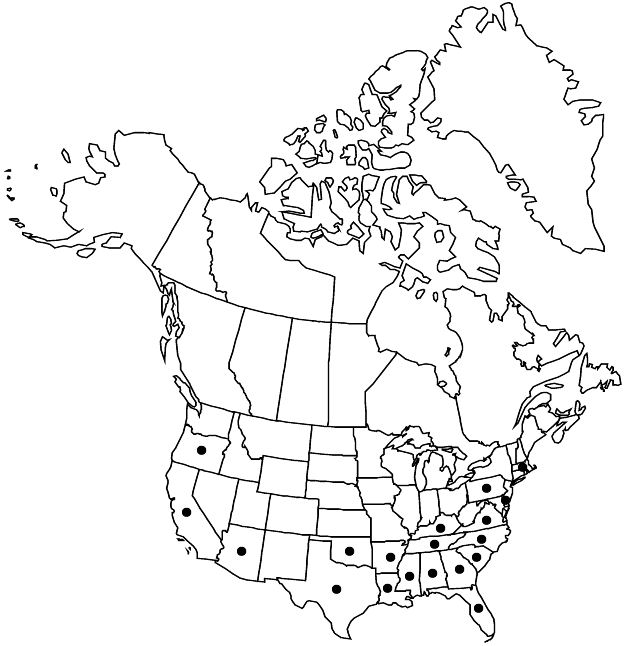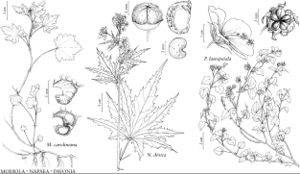Difference between revisions of "Modiola caroliniana"
Gen. Hist. 1: 466. 1831.
FNA>Volume Importer |
imported>Volume Importer |
||
| Line 52: | Line 52: | ||
|elevation=0–400 m | |elevation=0–400 m | ||
|distribution=Ala.;Ariz.;Ark.;Calif.;Del.;Fla.;Ga.;Ky.;La.;Mass.;Miss.;N.C.;Okla.;Oreg.;Pa.;S.C.;Tenn.;Tex.;Va.;South America;introduced also in Mexico;Central America;Pacific Islands (Hawaii). | |distribution=Ala.;Ariz.;Ark.;Calif.;Del.;Fla.;Ga.;Ky.;La.;Mass.;Miss.;N.C.;Okla.;Oreg.;Pa.;S.C.;Tenn.;Tex.;Va.;South America;introduced also in Mexico;Central America;Pacific Islands (Hawaii). | ||
| + | |introduced=true | ||
|discussion=<p><i>Modiola caroliniana</i> is somewhat weedy but not a serious agricultural weed. It has been reported in Delaware, Massachusetts, New Jersey, and Pennsylvania as a waif but doubtfully persists that far north. It is well established in the southeastern United States and is rather common as a lawn weed in some locations and as a garden weed in California. It probably came from southern South America in wool or cotton. Its closest relative, Modiolastrum K. Schumann, is known from southern South America.</p> | |discussion=<p><i>Modiola caroliniana</i> is somewhat weedy but not a serious agricultural weed. It has been reported in Delaware, Massachusetts, New Jersey, and Pennsylvania as a waif but doubtfully persists that far north. It is well established in the southeastern United States and is rather common as a lawn weed in some locations and as a garden weed in California. It probably came from southern South America in wool or cotton. Its closest relative, Modiolastrum K. Schumann, is known from southern South America.</p> | ||
|tables= | |tables= | ||
| Line 76: | Line 77: | ||
|publication year=1831 | |publication year=1831 | ||
|special status=Illustrated;Introduced;Weedy | |special status=Illustrated;Introduced;Weedy | ||
| − | |source xml=https:// | + | |source xml=https://bibilujan@bitbucket.org/aafc-mbb/fna-data-curation.git/src/bb6b7e3a7de7d3b7888a1ad48c7fd8f5c722d8d6/coarse_grained_fna_xml/V6/V6_552.xml |
|subfamily=Malvaceae subfam. Malvoideae | |subfamily=Malvaceae subfam. Malvoideae | ||
|genus=Modiola | |genus=Modiola | ||
Revision as of 23:41, 27 May 2020
Stems: flowering apices often ascending, branched, usually 0.2–0.5 m, often rooting at nodes. Leaves: stipules 3–4 × 1.5–3 mm; petiole length 1–2 times blade; blade 1.5–4 × 1.5–4 cm. Pedicels usually shorter than subtending petioles, hairy; involucellar bractlets lanceolate, 4–5 mm. Flowers: calyx 5–7 mm, hairy, hairs simple, 1–2 mm; corolla erect, 6–8 mm; staminal column yellowish; anthers crowded at apex; stigmas equaling number of locules. Mericarps drying black, 5–6 mm, apical spines 1.5–3 mm. Seeds 1.5 mm. 2n = 18.
Phenology: Flowering Mar–Nov.
Habitat: Disturbed, usually moist habitats, shores of ponds and reservoirs, low sandy areas, lawns, roadsides
Elevation: 0–400 m
Distribution

Introduced; Ala., Ariz., Ark., Calif., Del., Fla., Ga., Ky., La., Mass., Miss., N.C., Okla., Oreg., Pa., S.C., Tenn., Tex., Va., South America, introduced also in Mexico, Central America, Pacific Islands (Hawaii).
Discussion
Modiola caroliniana is somewhat weedy but not a serious agricultural weed. It has been reported in Delaware, Massachusetts, New Jersey, and Pennsylvania as a waif but doubtfully persists that far north. It is well established in the southeastern United States and is rather common as a lawn weed in some locations and as a garden weed in California. It probably came from southern South America in wool or cotton. Its closest relative, Modiolastrum K. Schumann, is known from southern South America.
Selected References
None.
